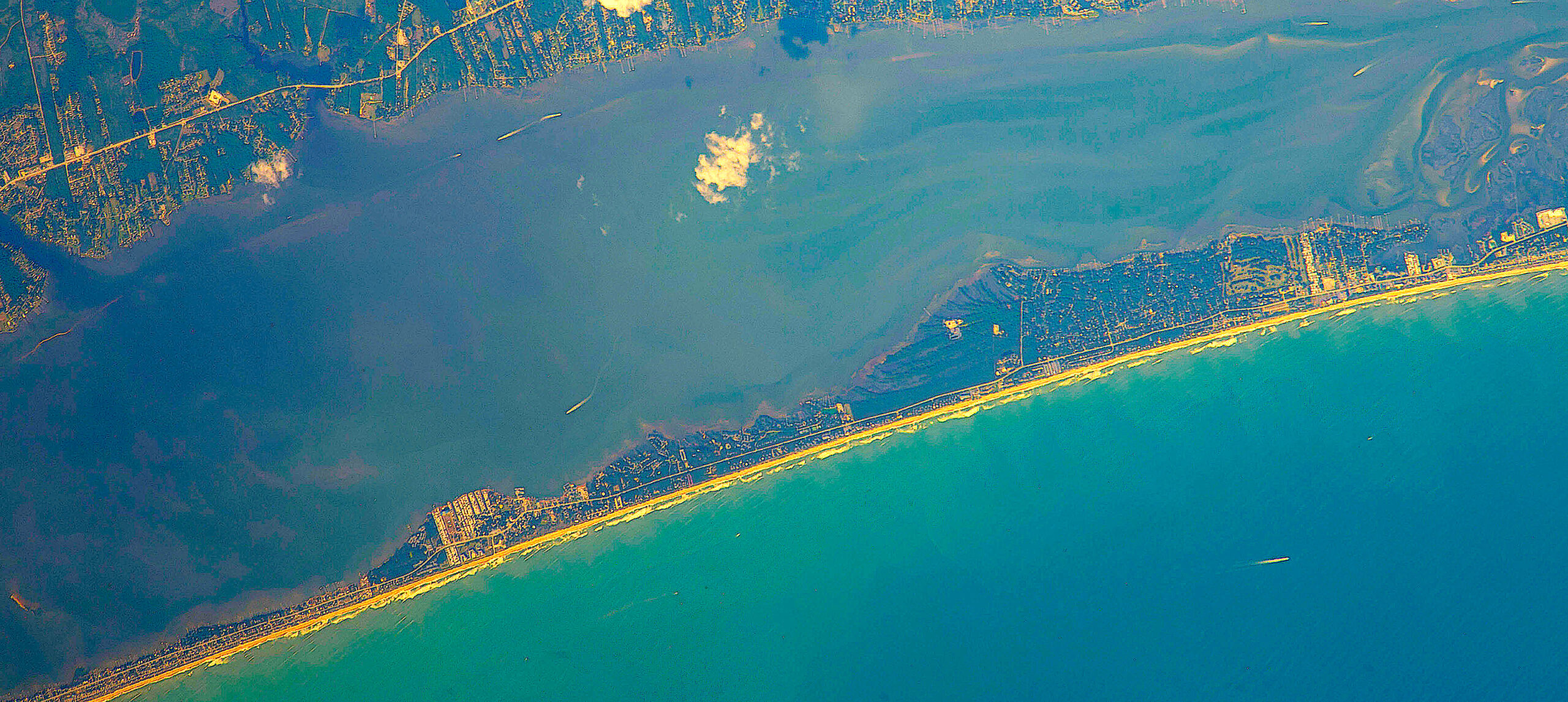SEA SCIENCE: Aquatic Robotics: Teens Plunge into Technology

At the Outer Banks YMCA swimming pool, several teenagers gather around an aquatic robot. The Cape Hatteras Secondary students lower the remotely operated vehicle (ROV) into the pool in Nags Head.
Once the ROV becomes submerged, two students click on the remote to move the rectangular-shaped robot through the water near a sheet of bubble wrap designed to look like a piece of ice. “Let’s go forward,” says Hatteras ninth-grader Terry Bobb to another teammate.
On the pool deck, another student looks at a TV camera as the robot moves forward.
“Remember in the competition you can’t talk to your team members,” says John McCord, education programs coordinator with the University of North Carolina Coastal Studies Institute (CSI) in Manteo. “You have 20 minutes in each mission.”
The Cape Hatteras Secondary students are practicing for a ROV contest organized by the Marine Advanced Technology Center (MATE). Manteo High School students also are participating in the practice session.
The competition challenges students to design and build ROVs to operate in a cold environment, according to McCord. “ROVs are used a lot in polar climates,” he says. “If you are studying plants or animals under ice, it is safer to use ROVs than divers.”
REGIONAL CONTEST
Manteo and Hatteras teams, as well as those from the N.C. School of Science and Mathematics and East Carteret High School, went on to compete in the 2007 mid-Atlantic regional competition. Hatteras won the “best school spirit” award.
Bill Evans, the Hatteras team’s sponsor and technology education teacher, says the ROV project fits in with his technology course.
“The competition falls under problem-solving in the curriculum,” Evans says.
Middle, high school, home school, community college and university students participate in the competition.
“This is a great hook for students,” says McCord, who coordinated the practice competition. “Who doesn’t like robots? And this gets them interested in marine science and technology.”
At regional contests, students are judged on a series of underwater missions, an engineering review and a poster display.
During one mission, students complete a series of tasks in an ice tank where the water surface can be frozen and the air temperature maintained at a uniform negative 30 to 15 degrees Celsius, simulating the polar environment. The first task involves collecting a benthic jellyfish found on the ocean floor. Next, robots collect a sample of algae and then deploy a passive acoustic sensor.
Winners of the regional contests went on to the international competition in Newfoundland in June. There, students submitted a technical report and participated in a mission in an environment like the extreme ocean conditions of polar regions, including wind, waves and currents. Real ice was used.
The MATE Center at Monterey Peninsula College in Monterey, Calif., was started in 1997 with funding from the National Science Foundation’s Advanced Technological Education Program. The center’s main goal is to improve the education and training of people interested in ocean occupations.
The ROV competition gives young people a great opportunity to be exposed to marine science mentors from NASA and NOAA, according to McCord. Also, they become familiar with viable technology, he adds.
Terri Kirby Hathaway of North Carolina Sea Grant says that technicians for ROVs — which usually include tethers — and autonomous underwater vehicles (AUVs) — which are unmanned, computer-operated and free of tethers — are coming front and center in marine careers. “ROVs and AUVs are the best way to do research in deep water,” adds Hathaway, a marine education specialist. “People will need to be trained to operate them.”
OCEAN EXPLORATION
Less than 5 percent of the world’s ocean has been explored, according to the National Undersea Research Program (NURP).
With the addition of a video camera and lights, ROVs serve as “underwater eyes” during explorations where divers or other submersibles cannot be used due to safety or weather conditions. Someone aboard a surface vessel operates the robot.
The underwater robots range in size from a bread box to a small truck, according to the NOAA Ocean Explorer online site. Deployment and recovery operations vary — from dropping the ROV over the side of a small boat to complex deck operations involving large winches for lifting and A-frames for swinging the ROV to the bottom.
The U.S. Navy first used ROVs in the 1960s to perform deep-sea rescue operations to recover objects from the ocean floor. Later, the oil and gas industry began using robots for offshore sites. During the mid-1980s, the marine research industry began using ROVs to study deep sea resources and environments.
At NURP’s Southeast Regional Center at the University of North Carolina Wilmington, scientists have used the ROV Phantom 300 to ground-truth acoustic maps, which involves collecting samples and images of ocean habitats in water deeper than 40 meters.
“Scuba divers are limited to the amount of time they can spend on the bottom,” says Andy Shepard, the center director. “For preliminary survey work, we used our Phantom ROVs to assess the number of fish on a reef site and the condition of their habitats.”
ROVs also are used to explore shipwrecks and natural resources in NOAA’s National Marine Sanctuaries — from the warm waters of Hawaii to the cold freshwater of Lake Huron in Michigan. The Monitor National Marine Sanctuary employs ROVs to document and explore the wreck site of the famous Civil War Ironclad USS Monitor, which lies 16 miles off Cape Hatteras, North Carolina and at other shipwrecks in the Graveyard of the Atlantic.
And aquatic robots are used at marine protected areas, including the Snowy Grouper wreck area off Cape Fear. The South Atlantic Fishery Management Council is considering closing the Grouper site and using it as a new marine reserve, according to Shepard.
In addition, NURP researchers use aquatic robots to study lionfish — a marine invasive fish that lives more than 130 feet underwater, well beyond safe depths for air or nitrox scuba dives.
“ROVs can be used to do long transects in deep water,” Shepard says. This works well for lionfish because they usually stay still while being photographed, he adds.
And when observing equipment is placed in offshore ocean sites, ROVs are used to rescue lost gear and maintain equipment. “The National Office for Integrated and Sustained Ocean Observations is planning to expand its underwater weather station network,” Shepard says.
“Maintaining the network will be a lot more challenging than on land and will require advanced undersea robots and the expertise to build and run them.”
ROV PROJECT
For the MATE competitions, students design and construct their own aquatic robots. For example, Cape Hatteras teenagers used PVC pipes, Styrofoam, an Ethernet cable, waterproof battery and wires.
“Overall, it has taken about two months to build the ROV,” Bobb says. “We made it in the classroom.”
For both the Manteo and Hatteras students, the ROVs evolved through trial and error. At a practice session, Manteo students find that the ROV is too large and not buoyant enough.
“Our main problem is the size and not having a motor that is powerful enough,” says Karra Shimabukuro, a Manteo English teacher and group sponsor.
But by working through problems, students learned about team building.
“It is a good project,” Bobb says. “We learned if you don’t work together, nothing gets done.”
And it gives the students hand-on experience with marine technology.
“This is pretty neat,” says Vince Simansky, father of Manteo High student Andrew Simansky.
“It makes the students think on a different level and gives them realistic work.”
To learn more about MATE program, visit the Web: www.marinetech.org/.
This article was published in the High Season 2007 issue of Coastwatch.
For contact information and reprint requests, visit ncseagrant.ncsu.edu/coastwatch/contact/.
- Categories:


